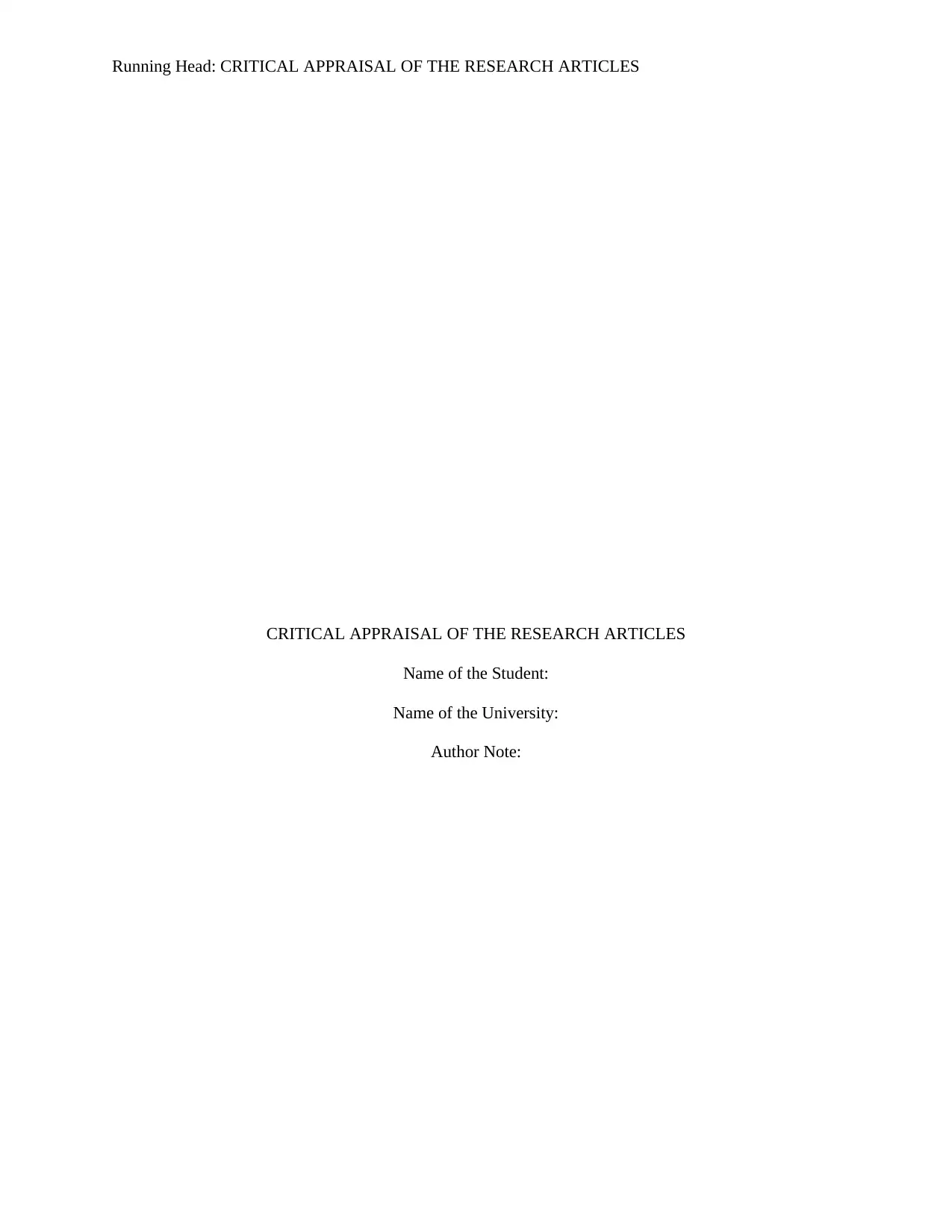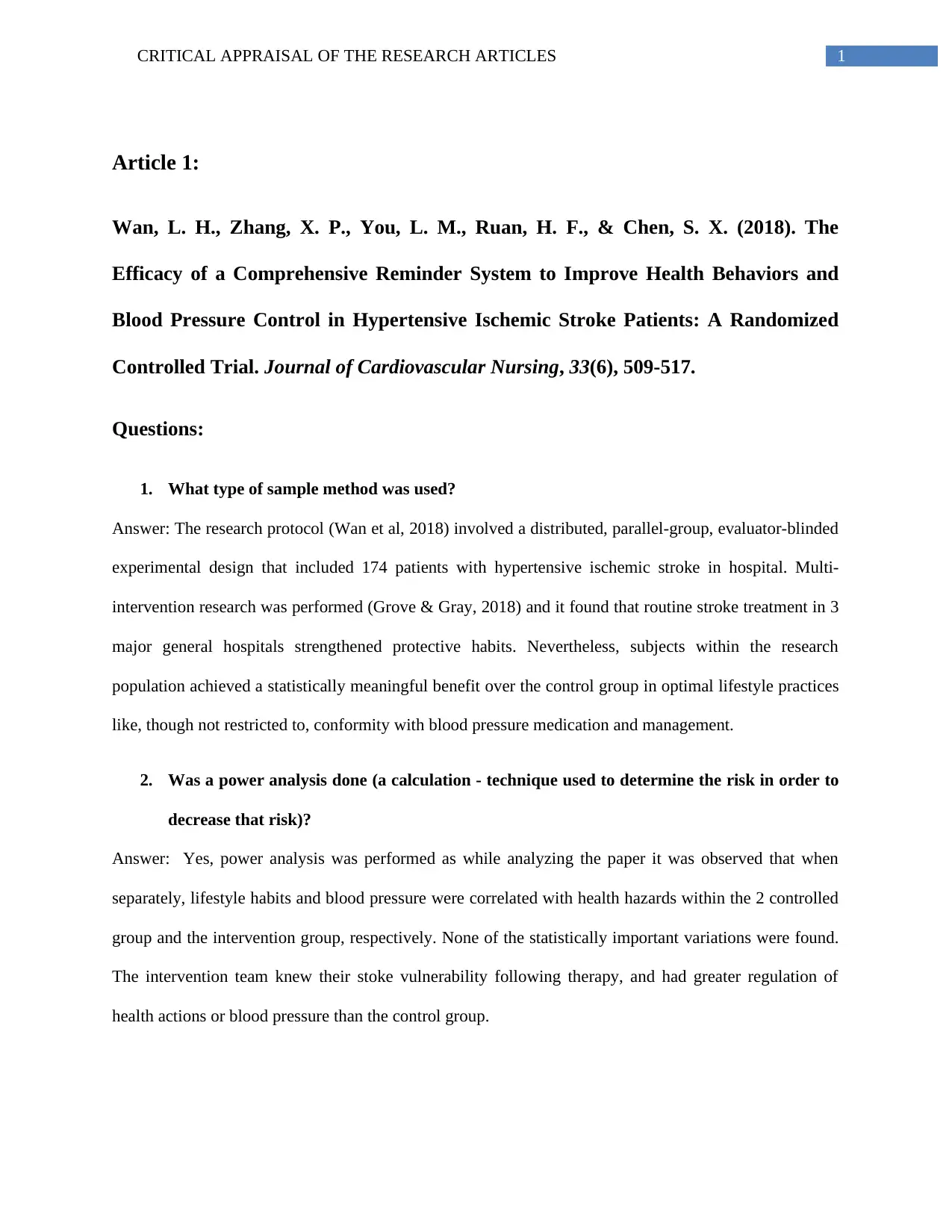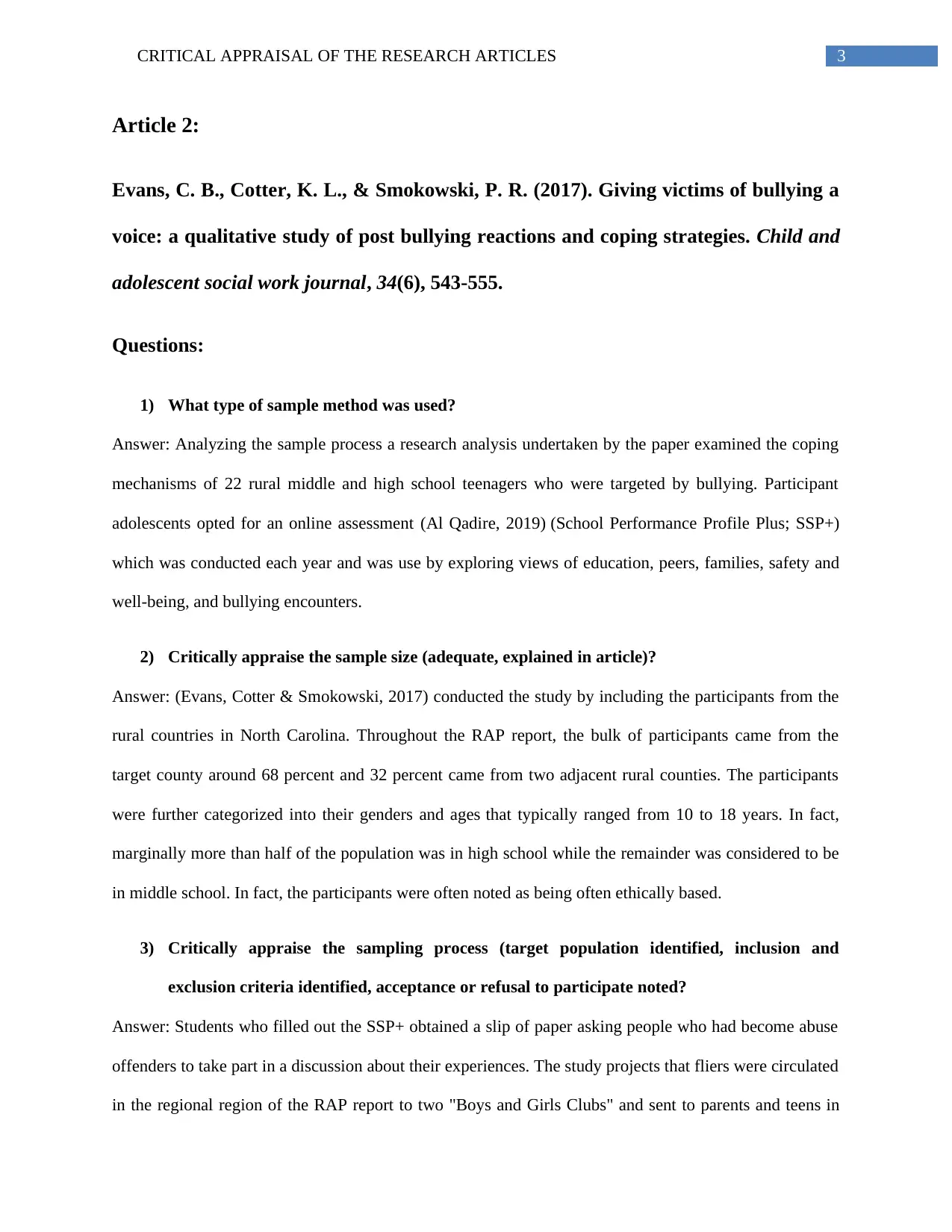PNUR129C108 Assignment: Critical Appraisal of Research Articles
VerifiedAdded on 2022/08/27
|6
|1396
|17
Homework Assignment
AI Summary
This assignment presents a critical appraisal of two research articles. The first article, by Wan et al. (2018), investigates the efficacy of a comprehensive reminder system on health behaviors and blood pressure control in hypertensive ischemic stroke patients. The appraisal examines the sampling method, power analysis, sample size adequacy, and sampling process, including target population, inclusion/exclusion criteria, and participant acceptance. The second article, by Evans et al. (2017), explores coping strategies of bullying victims. The analysis scrutinizes the sampling method, sample size adequacy, and the sampling process, including the identification of the target population and the recruitment of participants. The assignment provides a detailed evaluation of each article's methodology, offering insights into the strengths and weaknesses of the research designs.

Running Head: CRITICAL APPRAISAL OF THE RESEARCH ARTICLES
CRITICAL APPRAISAL OF THE RESEARCH ARTICLES
Name of the Student:
Name of the University:
Author Note:
CRITICAL APPRAISAL OF THE RESEARCH ARTICLES
Name of the Student:
Name of the University:
Author Note:
Paraphrase This Document
Need a fresh take? Get an instant paraphrase of this document with our AI Paraphraser

1CRITICAL APPRAISAL OF THE RESEARCH ARTICLES
Article 1:
Wan, L. H., Zhang, X. P., You, L. M., Ruan, H. F., & Chen, S. X. (2018). The
Efficacy of a Comprehensive Reminder System to Improve Health Behaviors and
Blood Pressure Control in Hypertensive Ischemic Stroke Patients: A Randomized
Controlled Trial. Journal of Cardiovascular Nursing, 33(6), 509-517.
Questions:
1. What type of sample method was used?
Answer: The research protocol (Wan et al, 2018) involved a distributed, parallel-group, evaluator-blinded
experimental design that included 174 patients with hypertensive ischemic stroke in hospital. Multi-
intervention research was performed (Grove & Gray, 2018) and it found that routine stroke treatment in 3
major general hospitals strengthened protective habits. Nevertheless, subjects within the research
population achieved a statistically meaningful benefit over the control group in optimal lifestyle practices
like, though not restricted to, conformity with blood pressure medication and management.
2. Was a power analysis done (a calculation - technique used to determine the risk in order to
decrease that risk)?
Answer: Yes, power analysis was performed as while analyzing the paper it was observed that when
separately, lifestyle habits and blood pressure were correlated with health hazards within the 2 controlled
group and the intervention group, respectively. None of the statistically important variations were found.
The intervention team knew their stoke vulnerability following therapy, and had greater regulation of
health actions or blood pressure than the control group.
Article 1:
Wan, L. H., Zhang, X. P., You, L. M., Ruan, H. F., & Chen, S. X. (2018). The
Efficacy of a Comprehensive Reminder System to Improve Health Behaviors and
Blood Pressure Control in Hypertensive Ischemic Stroke Patients: A Randomized
Controlled Trial. Journal of Cardiovascular Nursing, 33(6), 509-517.
Questions:
1. What type of sample method was used?
Answer: The research protocol (Wan et al, 2018) involved a distributed, parallel-group, evaluator-blinded
experimental design that included 174 patients with hypertensive ischemic stroke in hospital. Multi-
intervention research was performed (Grove & Gray, 2018) and it found that routine stroke treatment in 3
major general hospitals strengthened protective habits. Nevertheless, subjects within the research
population achieved a statistically meaningful benefit over the control group in optimal lifestyle practices
like, though not restricted to, conformity with blood pressure medication and management.
2. Was a power analysis done (a calculation - technique used to determine the risk in order to
decrease that risk)?
Answer: Yes, power analysis was performed as while analyzing the paper it was observed that when
separately, lifestyle habits and blood pressure were correlated with health hazards within the 2 controlled
group and the intervention group, respectively. None of the statistically important variations were found.
The intervention team knew their stoke vulnerability following therapy, and had greater regulation of
health actions or blood pressure than the control group.

2CRITICAL APPRAISAL OF THE RESEARCH ARTICLES
3. Critically appraise the sample size (adequate, explained in article)?
Answer: In 3 large general hospitals hypertensive ischemic stroke cases were drawn from 5 divisions of
neurology. Test coordinators recruited and allocated patients by the researcher / principal investigator (PI)
to either the control or intervention category according to random-sequence, computer-generated serial
numbers. The sample size was determined using variations in blood pressure between categories. In this
analysis the mean variation in SBP was usually distributed at 3 months post discharge with an average of
4.23 mm Hg and a total standard deviation of 8.7 mm Hg. Sealed, labeled, opaque envelopes held a
folded allocation file. Individuals that did not have patient communication performed data entry. All
participants in the sample provided treatment as normal, including clinical awareness during
hospitalization, a handout on stroke prevention, outpatient service follow-up by physicians and telephone
follow-up by nurses at 1 week and 1 month after discharge.
4. Critically appraise the sampling process (target population identified, inclusion and
exclusion criteria identified, acceptance or refusal to participate noted?
Answer: The study procedure (Grove & Gray, 2018) comprised a clustered, parallel-group, evaluator-
blinded trial design that included 174 hospitalized patients with hypertensive ischemic stroke. The
therapy consisted of mobile and face-to-face health conviction counseling, a patient schedule handbook,
and frequent electronic quick messaging services. Baseline data were later obtained, post 3 months after
discharge. The therapy participant demonstrated clinically, slightly improved lifestyle habits for physical
exercise, sleep, low-salt diet and commitment to medicine, three months after discharge. The intervention
participant has had statistically slightly lowered systolic blood pressure and decreased degree of
regulation of blood pressure. However, the behaviors including smoking and drug consumption were
observed to remain same.
3. Critically appraise the sample size (adequate, explained in article)?
Answer: In 3 large general hospitals hypertensive ischemic stroke cases were drawn from 5 divisions of
neurology. Test coordinators recruited and allocated patients by the researcher / principal investigator (PI)
to either the control or intervention category according to random-sequence, computer-generated serial
numbers. The sample size was determined using variations in blood pressure between categories. In this
analysis the mean variation in SBP was usually distributed at 3 months post discharge with an average of
4.23 mm Hg and a total standard deviation of 8.7 mm Hg. Sealed, labeled, opaque envelopes held a
folded allocation file. Individuals that did not have patient communication performed data entry. All
participants in the sample provided treatment as normal, including clinical awareness during
hospitalization, a handout on stroke prevention, outpatient service follow-up by physicians and telephone
follow-up by nurses at 1 week and 1 month after discharge.
4. Critically appraise the sampling process (target population identified, inclusion and
exclusion criteria identified, acceptance or refusal to participate noted?
Answer: The study procedure (Grove & Gray, 2018) comprised a clustered, parallel-group, evaluator-
blinded trial design that included 174 hospitalized patients with hypertensive ischemic stroke. The
therapy consisted of mobile and face-to-face health conviction counseling, a patient schedule handbook,
and frequent electronic quick messaging services. Baseline data were later obtained, post 3 months after
discharge. The therapy participant demonstrated clinically, slightly improved lifestyle habits for physical
exercise, sleep, low-salt diet and commitment to medicine, three months after discharge. The intervention
participant has had statistically slightly lowered systolic blood pressure and decreased degree of
regulation of blood pressure. However, the behaviors including smoking and drug consumption were
observed to remain same.
⊘ This is a preview!⊘
Do you want full access?
Subscribe today to unlock all pages.

Trusted by 1+ million students worldwide

3CRITICAL APPRAISAL OF THE RESEARCH ARTICLES
Article 2:
Evans, C. B., Cotter, K. L., & Smokowski, P. R. (2017). Giving victims of bullying a
voice: a qualitative study of post bullying reactions and coping strategies. Child and
adolescent social work journal, 34(6), 543-555.
Questions:
1) What type of sample method was used?
Answer: Analyzing the sample process a research analysis undertaken by the paper examined the coping
mechanisms of 22 rural middle and high school teenagers who were targeted by bullying. Participant
adolescents opted for an online assessment (Al Qadire, 2019) (School Performance Profile Plus; SSP+)
which was conducted each year and was use by exploring views of education, peers, families, safety and
well-being, and bullying encounters.
2) Critically appraise the sample size (adequate, explained in article)?
Answer: (Evans, Cotter & Smokowski, 2017) conducted the study by including the participants from the
rural countries in North Carolina. Throughout the RAP report, the bulk of participants came from the
target county around 68 percent and 32 percent came from two adjacent rural counties. The participants
were further categorized into their genders and ages that typically ranged from 10 to 18 years. In fact,
marginally more than half of the population was in high school while the remainder was considered to be
in middle school. In fact, the participants were often noted as being often ethically based.
3) Critically appraise the sampling process (target population identified, inclusion and
exclusion criteria identified, acceptance or refusal to participate noted?
Answer: Students who filled out the SSP+ obtained a slip of paper asking people who had become abuse
offenders to take part in a discussion about their experiences. The study projects that fliers were circulated
in the regional region of the RAP report to two "Boys and Girls Clubs" and sent to parents and teens in
Article 2:
Evans, C. B., Cotter, K. L., & Smokowski, P. R. (2017). Giving victims of bullying a
voice: a qualitative study of post bullying reactions and coping strategies. Child and
adolescent social work journal, 34(6), 543-555.
Questions:
1) What type of sample method was used?
Answer: Analyzing the sample process a research analysis undertaken by the paper examined the coping
mechanisms of 22 rural middle and high school teenagers who were targeted by bullying. Participant
adolescents opted for an online assessment (Al Qadire, 2019) (School Performance Profile Plus; SSP+)
which was conducted each year and was use by exploring views of education, peers, families, safety and
well-being, and bullying encounters.
2) Critically appraise the sample size (adequate, explained in article)?
Answer: (Evans, Cotter & Smokowski, 2017) conducted the study by including the participants from the
rural countries in North Carolina. Throughout the RAP report, the bulk of participants came from the
target county around 68 percent and 32 percent came from two adjacent rural counties. The participants
were further categorized into their genders and ages that typically ranged from 10 to 18 years. In fact,
marginally more than half of the population was in high school while the remainder was considered to be
in middle school. In fact, the participants were often noted as being often ethically based.
3) Critically appraise the sampling process (target population identified, inclusion and
exclusion criteria identified, acceptance or refusal to participate noted?
Answer: Students who filled out the SSP+ obtained a slip of paper asking people who had become abuse
offenders to take part in a discussion about their experiences. The study projects that fliers were circulated
in the regional region of the RAP report to two "Boys and Girls Clubs" and sent to parents and teens in
Paraphrase This Document
Need a fresh take? Get an instant paraphrase of this document with our AI Paraphraser

4CRITICAL APPRAISAL OF THE RESEARCH ARTICLES
community programs as well, but neither reached the analysis team. Since volunteers were too
challenging to find, researchers called one of the RAP programs, the Administrator of a Teen Court
program. This recruiting technique culminated in eight teenagers from Teen Court deciding to engage in
the report. Seven young people in the same county learned of the interviews from their social networks
and Semi-structured interviews were held in a private office, and recorded audio. The Teen Court
Director started interviewing applicants at Teen Court and urged any youth who recorded encounters of
victimizing bullying to contact the researchers. Two participants (the first and second authors) performed
the first nine interviews to allow for in-depth examination of the interview material and to provide an
overview of what follow-up questions would be expected. The first researcher conducted the following 13
interviews independently. Nevertheless, all interviews were planned using an interview template, follow-
up questions were posed by the interviewees and unexpected leads were followed where appropriate.
community programs as well, but neither reached the analysis team. Since volunteers were too
challenging to find, researchers called one of the RAP programs, the Administrator of a Teen Court
program. This recruiting technique culminated in eight teenagers from Teen Court deciding to engage in
the report. Seven young people in the same county learned of the interviews from their social networks
and Semi-structured interviews were held in a private office, and recorded audio. The Teen Court
Director started interviewing applicants at Teen Court and urged any youth who recorded encounters of
victimizing bullying to contact the researchers. Two participants (the first and second authors) performed
the first nine interviews to allow for in-depth examination of the interview material and to provide an
overview of what follow-up questions would be expected. The first researcher conducted the following 13
interviews independently. Nevertheless, all interviews were planned using an interview template, follow-
up questions were posed by the interviewees and unexpected leads were followed where appropriate.

5CRITICAL APPRAISAL OF THE RESEARCH ARTICLES
References:
Al Qadire, M. (2019). Undergraduate student nurses' knowledge of evidence-based practice: A short
online survey. Nurse education today, 72, 1-5.
Evans, C. B., Cotter, K. L., & Smokowski, P. R. (2017). Giving victims of bullying a voice: a qualitative
study of post bullying reactions and coping strategies. Child and adolescent social work
journal, 34(6), 543-555.
Grove, S. K., & Gray, J. R. (2018). Understanding Nursing Research E-Book: Building an Evidence-
Based Practice. Elsevier Health Sciences.
LoBiondo-Wood, G., & Haber, J. (2014). Nursing research-e-book: methods and critical appraisal for
evidence-based practice. Elsevier Health Sciences.
LoBiondo-Wood, G., & Haber, J. (2017). Nursing research-E-book: methods and critical appraisal for
evidence-based practice. Elsevier Health Sciences.
Wan, L. H., Zhang, X. P., You, L. M., Ruan, H. F., & Chen, S. X. (2018). The Efficacy of a
Comprehensive Reminder System to Improve Health Behaviors and Blood Pressure Control in
Hypertensive Ischemic Stroke Patients: A Randomized Controlled Trial. Journal of
Cardiovascular Nursing, 33(6), 509-517.
References:
Al Qadire, M. (2019). Undergraduate student nurses' knowledge of evidence-based practice: A short
online survey. Nurse education today, 72, 1-5.
Evans, C. B., Cotter, K. L., & Smokowski, P. R. (2017). Giving victims of bullying a voice: a qualitative
study of post bullying reactions and coping strategies. Child and adolescent social work
journal, 34(6), 543-555.
Grove, S. K., & Gray, J. R. (2018). Understanding Nursing Research E-Book: Building an Evidence-
Based Practice. Elsevier Health Sciences.
LoBiondo-Wood, G., & Haber, J. (2014). Nursing research-e-book: methods and critical appraisal for
evidence-based practice. Elsevier Health Sciences.
LoBiondo-Wood, G., & Haber, J. (2017). Nursing research-E-book: methods and critical appraisal for
evidence-based practice. Elsevier Health Sciences.
Wan, L. H., Zhang, X. P., You, L. M., Ruan, H. F., & Chen, S. X. (2018). The Efficacy of a
Comprehensive Reminder System to Improve Health Behaviors and Blood Pressure Control in
Hypertensive Ischemic Stroke Patients: A Randomized Controlled Trial. Journal of
Cardiovascular Nursing, 33(6), 509-517.
⊘ This is a preview!⊘
Do you want full access?
Subscribe today to unlock all pages.

Trusted by 1+ million students worldwide
1 out of 6
Related Documents
Your All-in-One AI-Powered Toolkit for Academic Success.
+13062052269
info@desklib.com
Available 24*7 on WhatsApp / Email
![[object Object]](/_next/static/media/star-bottom.7253800d.svg)
Unlock your academic potential
Copyright © 2020–2025 A2Z Services. All Rights Reserved. Developed and managed by ZUCOL.




